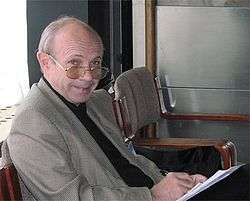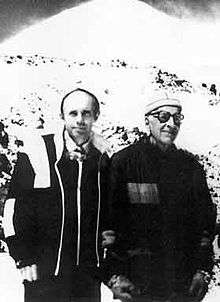Yuri G. Zdesenko
Yuri G. Zdesenko (Ukrainian: Здесенко Юрій Георгійович); 6 October 1943 – 1 September 2004, was a Ukrainian nuclear physicist known for a significant contribution to investigations of double beta decay.
Yuri G. Zdesenko | |
|---|---|
 | |
| Born | 6 October 1943 |
| Died | 1 September 2004 (aged 60) |
| Nationality | Soviet Union, Ukraine |
| Alma mater | Taras Shevchenko National University of Kyiv |
| Known for | Double beta decay |
| Awards | the State prize of Ukraine in science and technology 2016 (posthumously) |
| Scientific career | |
| Fields | Nuclear physics, Astroparticle physics |
| Institutions | Taras Shevchenko National University of Kyiv Institute of Geochemistry and Physics of Minerals Institute for Nuclear Research of NASU |
Early life
Yuri G. Zdesenko was born on 6 October 1943 in Dmytrivka, Bakhmach Raion, Chernihiv Oblast, Ukrainian Soviet Socialist Republic of the Soviet Union to Soviet Army officer Georgy Zdesenko.
Academic career
In 1970 Zdesenko was graduated from the Department of Physics of the T.G.Shevchenko Kyiv State University. He obtained degrees of Candidate of Sciences (Philosophy Doctor) in 1981 (Institute for Nuclear Research, Moscow, Soviet Union), Doktor nauk in 1990 (Institute for Nuclear Research, Kiev, Ukrainian Soviet Socialist Republic) and the academic rank of Full Professor in 2000 (Institute for Nuclear Research, Kiev, Ukraine). Taking into account his outstanding scientific achievements, Zdesnko was elected in 2003 a Corresponding Member of the National Academy of Sciences of Ukraine.
Research
Zdesenko started researches in the Laboratory of Nuclear Physics of the T.G. Shevchenko Kyiv State University (1970-1971) and then in the Institute of Geochemistry and Physics of Minerals (1971-1980) where he dealt with neutron activation analysis of minerals and radiocarbon dating. At that time he became interested in double beta decay of atomic nuclei.[1]
In 1980 he created the Laboratory for Low Background Measurements of the Special Construction Technological Center of the Institute for Nuclear Research of the Ukrainian Academy of Sciences (1980-1986) where searches for the double beta decay of 130Te,[2] 96Zr[3] and 100Mo[4] were realized. In 1986 the laboratory was transformed to the Lepton Physics Department of the Institute for Nuclear Research (Kiev, Ukraine).
In the early 1980s Zdesenko, supported by Bruno Pontecorvo (who was at that time head of the neutrino council of the Soviet Academy of Sciences),

initiated construction of the Solotvina Underground Laboratory in Solotvina, at the Zakarpattia Oblast on the west of Ukraine. The Laboratory was located in a salt mine at a depth of 430 m. Low counting experiments were started in the Solotvina laboratory in 1984. Investigations of rare nuclear alpha and beta decays, searches for neutrinoless double beta decay of atomic nuclei were performed in the laboratory. The most valuable results obtained in the Solotvina Underground Laboratory are as following:
- the most stringent limits on neutrinoless double beta decay of 116Cd obtained with the help of cadmium tungstate crystal scintillators enriched in isotope 116Cd at 83%. One of the most stringent limits on the effective Majorana neutrino mass was derived from the experiments;[5][6][7]
- observation of the two neutrino double beta decay of 116Cd;[8][7]
- first observation of the alpha activity of tungsten (isotope 180W);[9][10]
- investigation of rare beta decay of 113Cd;[11][12]
- search for neutrinoless double beta decay of 160Gd[13][14] and 186W.[7]
- development of low background technique for low counting experiments,[10][15] in particular, the cadmium tungstate crystal scintillators from enriched isotope cadmium 116 [5]
Yu.G. Zdesenko and his group have also contributed to searches for hypothetical decays beyond the Standard Model: decays of nucleons into invisible channels,[10][16] decays of electron with non-conservation of the electric charge,[17] charge-non-conserving β decays.[18] Yuri G. Zdesenko is author or coauthor of above 300 scientific publications for which there are more than 1500 references in papers of other authors.
References
- Y.G. Zdesenko, "Double β decay and conservation of lepton charge." Sov. J. Part. Nucl. 11 (1980) 542.
- Y.G. Zdesenko et al., "Study of the double β decay of 130Te" Sov. J. Nucl. Phys. 32 (1980) 312.
- Yu.G. Zdesenko et al., "Search of 96Zr neutrinoless double β-decay" Izvestiya Akademii Nauk SSSR, Seriya Fizicheskaya 45 (1981) 1856.
- Y.G. Zdesenko et al.,"Study on the double beta decay of 100Mo" Izvestiya Akademii Nauk SSSR, Seriya Fizicheskaya 28 (1983) 839.
- F.A. Danevich et al., "Search for 2β decay of 116Cd with the help of a 116CdWO4 scintillator" JETP Lett. 49 (1989) 476.
- F.A. Danevich et al., "The research of 2β decay of 116Cd with enriched 116CdWO4 crystal scintillators" Phys. Lett. B 344 (1995) 72.
- F.A. Danevich et al., "Search for 2β decay of cadmium and tungsten isotopes: Final results of the Solotvina experiment Phys. Rev. C 68 (2003) 035501.
- F.A. Danevich et al., "Two-neutrino 2β decay of 116Cd and new half-life limits on 2β decay of 180W and 186W Nucl. Phys. A 717 (2003) 129.
- F.A. Danevich et al., "α activity of natural tungsten isotopes" Phys. Rev. C 67 (2003) 014310
- Yu.G. Zdesenko et al., "Scintillation properties and radioactive contamination of CaWO4 crystal scintillators" Nucl. Instrum. Meth. A 538 (2005) 657.
- A. Alessandrello et al., "Bolometric measurement of the beta spectrum of 113Cd" Nucl. Phys. B (Proc. Suppl.) 35 (1994) 394.
- F.A. Danevich et al., "Beta decay of 113Cd" Phys. At. Nucl. 59 (1996) 1.
- S.F. Burachas et al., "A search for 160Gd double beta decay using GSO scintillators" Phys. At. Nucl. 58 (1995) 153.
- F.A.Danevich et al., " Quest for double beta decay of 160Gd and Ce isotopes" Nucl. Phys. A 694 (2001) 375.
- F.A.Danevich et al., "ZnWO4 crystals as detectors for 2β decay and dark matter experiments" Nucl. Instrum. Meth. A 544 (2005) 553.
- R. Bernabei et al., "Search for the nucleon and di-nucleon decay into invisible channels" Phys. Lett. B 493 (2000) 12.
- P. Belli et al., "Charge non-conservation restrictions from the nuclear levels excitation of 129Xe induced by the electron's decay on the atomic shell" Phys. Lett. B 465 (1999) 315.
- A.A. Klimenko et al., "Experimental limit on the charge non-conserving β decay of 73Ge" Phys. Lett. B 535 (2002) 77.